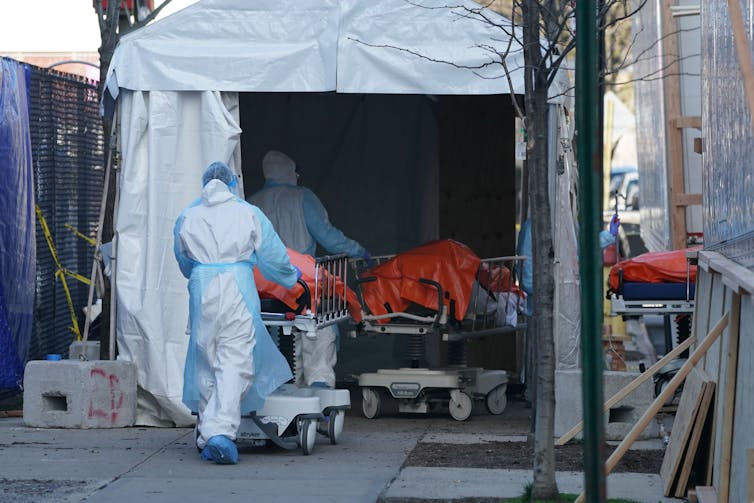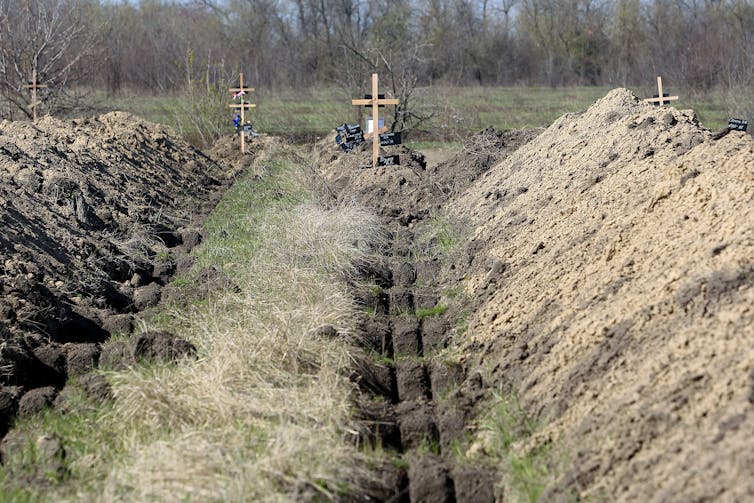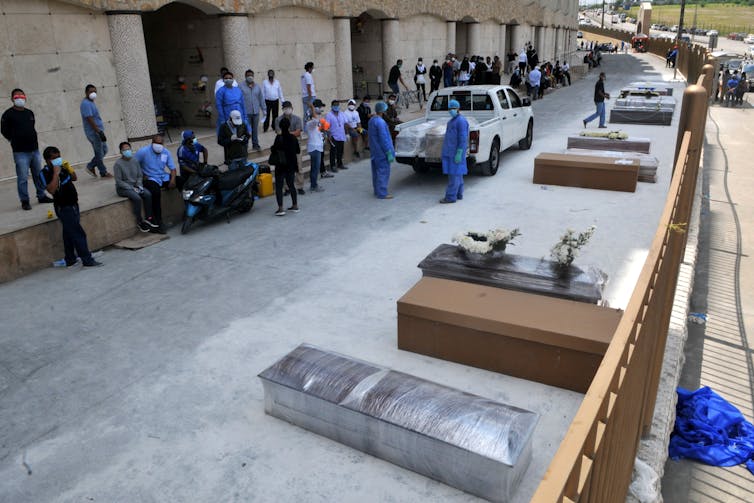Overloaded morgues, mass graves and infectious remains: How forensic pathologists handle the coronavirus dead
- Written by Ahmad Samarji, Associate Professor of Forensic Science Education & STEM Education and the Assistant Dean of the College of Arts and Sciences, Phoenicia University
Editor’s note: Most scientists and doctors in the coronavirus crisis are working to save the living. Those in the field of forensic pathology, however, focus on the dead[1].
Ahmad Samarji, a Lebanon-based scholar of forensic science, reports on the extraordinary challenges facing coroners and pathologists in outbreak zones, where governments have to take “very limited but essential choices” to avoid a dangerous pileup of dead bodies. This Q+A has been edited and condensed for publication.
What is the role of forensic pathologists in a pandemic?
Forensic pathologists[2] are physicians who integrate law and medicine[3] to determine the cause, mechanism, manner and time of a person’s death. Their everyday work has important legal, social and economic consequences[4] for family members of the deceased and for the larger community.
During a pandemic, forensic pathologists are heavily involved in managing the crisis, either within their local communities or as part of a humanitarian mission working with vulnerable communities abroad.
Their role in these extremely challenging times is to ensure the proper management of dead bodies, minimizing the spread of the virus, and to guide authorities, hospitals and funeral directors about the “do’s and don'ts” of dealing with these bodies.
There is a general assumption in medicine that dealing with the deceased does not require the same urgency as working with an acutely ill patient, and normally that is true. However, in a pandemic like COVID-19, large numbers of the dead can quickly exceed local capacities if not managed in a timely manner.
With highly infectious diseases, it is urgent that the post-mortem procedures – from death, examination, certification, registration and release of the body to safe cremation or burial – flow as properly and smoothly as possible.
Are the bodies of COVID-19 victims infectious?
While a lot is known about the coronavirus family, much is yet to be understood about the transmission modes and effects on the body of SARS-CoV-2, the virus that causes COVID-19. We don’t know whether human remains are infectious, but the likelihood is high. So forensic pathologists around the world[5] are urging governments[6] to restrict viewing[7] and handling of the body after examination is completed[8].
During the Ebola epidemic – which claimed around 11,300 lives in West Africa between 2014 and 2015 – handling of the dead was one of the main modes of transmission of the disease[9]. So one of the lessons forensic humanitarians took from this experience[10] – which is now being applied to coronavirus – was that untrained first responders should not be involved in handling human remains during outbreaks of highly contagious diseases.
 Bodies are moved to a refrigerated truck serving as a temporary morgue for Wyckoff Hospital, Brooklyn, April 4, 2020 in New York City, where someone dies from COVID-19 every few minutes.
BRYAN R. SMITH/AFP via Getty Images[11]
Bodies are moved to a refrigerated truck serving as a temporary morgue for Wyckoff Hospital, Brooklyn, April 4, 2020 in New York City, where someone dies from COVID-19 every few minutes.
BRYAN R. SMITH/AFP via Getty Images[11]
Are cities with coronavirus outbreaks able to manage the dead safely?
With the death toll from coronavirus projected to exceed many hundreds of thousands worldwide[12], governments everywhere are scrambling. But health systems that have planned for pandemics – and allocated sufficient resources to manage them – seem to be in decent shape.
My colleague Dr. Ralph Bouhaidar – a consultant forensic pathologist at the University of Edinburgh – told me that in addition to spending long hours in the Edinburgh City Mortuary, he is closely collaborating with prosecutors, police, funeral directors and hospitals across Scotland to review, assess and update existing procedures for managing “excess deaths in a pandemic.”
Dr. Bouhaidar emphasized that an appropriate COVID-19 response does not “emerge from a vacuum.” Rather, he said, proper management of the dead is “the result of cumulative work and planning…to have an understanding of local capacities and study our resilience in dealing with such possibilities, whilst liaising nationally and internationally with colleagues to share knowledge and experiences.”
So far, with 4,565 confirmed COVID-19 cases and 366 dead[13], Scotland’s hospitals and morgue are not overwhelmed.
But there are grim reports from hard-hit cities – like New York and Guayaquil, Ecuador[14], for example – of coronavirus patients dying so fast that bodies are just piling up. Both cities are considering digging mass graves[15].
When national plans for managing dead bodies in pandemics are exhausted, it leads to the piling up of bodies, issues with storage and refrigeration, and decomposition. That, as a result, increases risk of infection across the community.
Under such conditions, local and federal governments have very limited – yet essential – choices to handle the volume of bodies.
They should allow for the certification of medical deaths due to COVID-19 by the treating clinician, without the need for a post-mortem examination, to enable a swifter flow of the deceased within the system. They must also set up temporary mortuaries big enough to accommodate thousands of bodies. British authorities, for example, are building a special COVID-19 mortuary at the Birmingham Airport to accommodate 12,000 bodies[16]. And, yes, they may need to excavate mass graves.
All this must be done while ensuring a dignified burial for the bodies and proper labeling of the graves as required by international humanitarian law[17].
 The eastern Ukrainian city of Dnipro has prepared more than 600 graves for coronavirus victims, April 7, 2020.
STANISLAV VEDMID/AFP via Getty Images[18]
The eastern Ukrainian city of Dnipro has prepared more than 600 graves for coronavirus victims, April 7, 2020.
STANISLAV VEDMID/AFP via Getty Images[18]
What dangers does the COVID-19 pandemic present for forensic scientists?
Despite all protective measures, forensic experts are at constant risk of exposure to this deadly virus. And when pathologists in hard-hit areas contract coronavirus, it intensifies a vicious cycle.
They must absent themselves from work for at least 14 days, and some will die. This worsens an already miserable situation with the handling of dead bodies and, as a result, threatens the health of the entire community.
Forensic scientists from the Red Cross are being sent into refugee camps, war zones[19] and overwhelmed cities on humanitarian COVID-19 missions to provide pandemic assistance. In these places, the risk of contagion is even greater. The morgues they work in there most likely face shortages of staff with expert skills and appropriately equipped mortuaries.
 People wait next to coffins and cardboard boxes to bury their loved ones outside a cemetery in Guayaquyil, Ecuador, April 6, 2020.
JOSE SANCHEZ/AFP via Getty Images[20]
People wait next to coffins and cardboard boxes to bury their loved ones outside a cemetery in Guayaquyil, Ecuador, April 6, 2020.
JOSE SANCHEZ/AFP via Getty Images[20]
Generally speaking, the forensic examination of a dead person doesn’t require highly complex equipment and machinery compared to other health specialties. Pathologists just need appropriate storage, personal protective equipment, basic dissection tools and specimen collection material.
But our work falls within a larger chains of events. Hospitals must have the capacity to identify the person, determine their cause of death, physically dispose of the body and work through the various legal complexities that these cases attract – and to do so swiftly.
You mentioned how forensic scientists learned about Ebola on the job. What are we learning about coronavirus that’s aiding the pandemic response?
The lessons from Ebola were reflected into the revised “Management of Dead Bodies following Disasters[21]” manual, published in 2016 by the World Health Organization and International Committee of the Red Cross, that is now aiding governments and first responders worldwide in the COVID-19 pandemic.
Today, cross-disciplinary research is underway about COVID-19 that connects the knowledge of forensic pathologists with that of clinical medical practitioners, virologists and biochemists.
In Italy, for example, a study published March 26[22], led by 25 health professionals across fields, warned health care professionals and morgue staff about specific risks in handling COVID-19 patients and provided guidance for autopsies of suspected, probable and confirmed cases of COVID-19.
Such work, when replicated and carried out across various research teams and countries, will greatly assist in managing this global crisis, formulating an effective treatment plan – and potentially creating a vaccine.
The Conversation is running a series of dispatches from clinicians and researchers operating on the front lines of the coronavirus pandemic. You can find all of the stories here[23].
References
- ^ focus on the dead (theconversation.com)
- ^ Forensic pathologists (www.crcpress.com)
- ^ law and medicine (www.sciencedirect.com)
- ^ legal, social and economic consequences (trove.nla.gov.au)
- ^ around the world (www.cdc.gov)
- ^ urging governments (www.ecdc.europa.eu)
- ^ restrict viewing (www.mohfw.gov.in)
- ^ handling of the body after examination is completed (www.moh.gov.my)
- ^ one of the main modes of transmission of the disease (international-review.icrc.org)
- ^ forensic humanitarians took from this experience (www.sciencedirect.com)
- ^ BRYAN R. SMITH/AFP via Getty Images (www.gettyimages.com)
- ^ projected to exceed many hundreds of thousands worldwide (www.nbcnews.com)
- ^ 4,565 confirmed COVID-19 cases and 366 dead (www.edinburghnews.scotsman.com)
- ^ Guayaquil, Ecuador (www.reuters.com)
- ^ digging mass graves (www.nytimes.com)
- ^ accommodate 12,000 bodies (www.itv.com)
- ^ required by international humanitarian law (ihl-databases.icrc.org)
- ^ STANISLAV VEDMID/AFP via Getty Images (www.gettyimages.com)
- ^ sent into refugee camps, war zones (www.icrc.org)
- ^ JOSE SANCHEZ/AFP via Getty Images (www.gettyimages.com)
- ^ Management of Dead Bodies following Disasters (www.paho.org)
- ^ a study published March 26 (www.pathologica.it)
- ^ all of the stories here (theconversation.com)
Authors: Ahmad Samarji, Associate Professor of Forensic Science Education & STEM Education and the Assistant Dean of the College of Arts and Sciences, Phoenicia University

